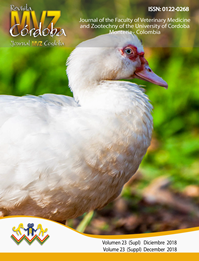The Madariaga virus follows the footsteps of the Chikungunya and Zika viruses
El virus Madariaga le sigue los pasos a los virus Chikungunya y Zika
Cómo citar
Salim, & Marco. (2018). The Madariaga virus follows the footsteps of the Chikungunya and Zika viruses. Revista MVZ Córdoba, 23(S), 6937-6941. https://doi.org/10.21897/rmvz.1480
Dimensions
Mostrar biografía de los autores
Visitas del artículo 1195 | Visitas PDF
Descargas
Los datos de descarga todavía no están disponibles.
- Silva MLCR, Auguste AJ, Terzian ACB, Vedovello D, Riet-Correa F, Macário VMK, et al. Isolation and Characterization of Madariaga Virus from a Horse in Paraíba State, Brazil. Transbound Emerg Dis. 2017; 64(3):990-993. DOI: 10.1111/tbed.12441.
- Vittor AY, Armien B, Gonzalez P, Carrera J, Dominguez C, Valderrama A, et al. Epidemiology o f Emergent Madariaga Encephalitis in a Region with Endemic Venezuelan Equine Encephalitis: Initial Host Studies and Human Cross-Sectional Study in Darien, Panama. PLoS Negl Trop Dis. 2016; 10(4):e0004554. doi: https://dx.doi. org/10.1371%2Fjournal.pntd.0004554
- Carrera JP, Bagamian KH, Travassos AP, Wang E, Beltran D, Gundaker ND, et al. Human and Equine Infection with Alphaviruses and Flaviviruses in Panamá during 2010: A CrossSectional Study of Household Contacts during an Encephalitis Outbreak. Am J Trop Med Hyg. 2018; 98(6):1798-1804. doi: https://doi. org/10.4269/ajtmh.17-0679
- Mattar VS, Guzmán TC, Calderón RA, González TM. Infecciones por arenavirus. Rev MVZ Cordoba. 2017; 22(Supl):6089-6100. DOI: http://dx.doi.org/10.21897/rmvz.1078
- Burgueño A, Frabasile S, Díaz LA, Cabrera A, Pisano MB, Rivarola ME, et al. Genomic Characterization and Seroprevalence Studies on Alphaviruses in Uruguay. Am J Trop Med Hyg. 2018; 98(6):1811-1818. doi: https:// doi.org/10.4269/ajtmh.17-0980
- Blohm GM, Lednicky JA, White SK, Mavian CN, Márquez MC, González-García KP. Madariaga Virus: Identification of a Lineage III Strain in a Venezuelan Child With Acute Undifferentiated Febrile Illness, in the Setting of a Possible Equine Epizootic. Clin Infect Dis. 2018; 67(4):619-621. doi: https://doi.org/10.1093/ cid/ciy224.
























